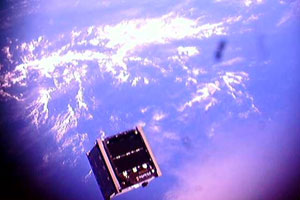 Cal Poly's CP-4 mini-satellite in orbit. Credit: The Aerospace
Cal Poly's CP-4 mini-satellite in orbit. Credit: The Aerospace
Corporation.
It's a classic engineering story - a garage inventor spends years working in isolation, only to produce something that gets the attention of the world. Ok, the CubeSat story may not be quite as romantic, but it does have a lot of the same ingredients.
Professors at Stanford University and Cal Poly created CubeSats - 10 by 10 by 10 centimeter mini-satellites - as enginneering projects to give their students hands-on experience. Compared to standard satellite missions, which can run hundreds of millions of dollars and take years to complete, CubeSat missions are mean to be done cheaply and quickly.
CubeSat is also a standard - a basic blueprint that any university program can use. CubeSats are actually known as "FedEx satellites," since universities can mail them to Cal Poly to arrange a ride into space. They've created launching devices called P-Pods (a box that fits the CubeSats perfectly) so they can piggyback on larger rocket launches. Once the main cargo is deployed, the P-Pod releases the CubeSats into orbit. Depending how high they are, CubeSats can orbit for more than a decade before they burn up in the atmosphere.
What started at universities has spread - NASA, Boeing and other aerospace companies all have mini-satellite programs. Despite the small size, CubeSats are actually able to do valuable research. They can space test new technology, submitting it to all the rigors of space travel like solar radiation and launch stress. Recreating those conditions on the ground can be very expensive.
